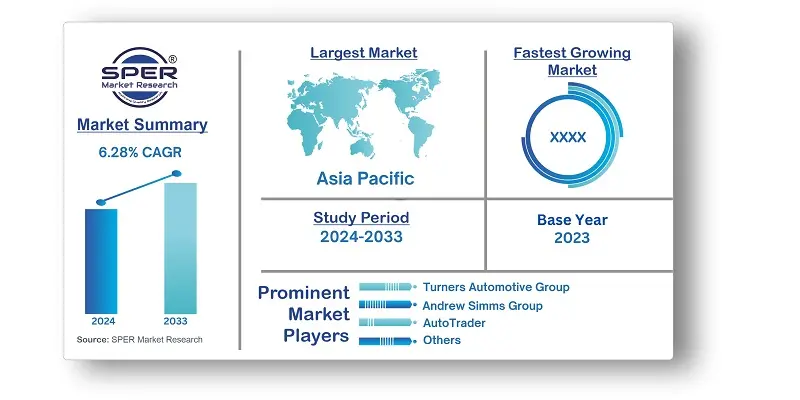
New Zealand Used Car Market Size, Growth, Trends, Demand, Revenue and Future Outlook
New Zealand Used Car Market Growth, Trends, Analysis, Size- By Vehicle Type, By Vendor Type, By Fuel Type - Regional Outlook, Competitive Strategies and Segment Forecast to 2033
| Published: Nov-2024 | Report ID: AMIN24242 | Pages: 1 - 108 | Formats*: |
| Category : Automotive & Transportation | |||
- In August 2023, BYD Co. Ltd. partnered with Andrew Simms, one of New Zealand's top dealer groups. The Andrew Simms Group increased the value of their brand nationwide as a result of this partnership.
- The New Zealand government implemented the Clean Car Fee/Rebate program in May 2023 in an effort to lower emissions from imported old automobiles.


| Report Metric | Details |
| Market size available for years | 2020-2033 |
| Base year considered | 2023 |
| Forecast period | 2024-2033 |
| Segments covered | By Vehicle Type, By Vendor Type, By Fuel Type. |
| Regions covered | Eastern region, Western region, Southern region, Northern region. |
| Companies Covered | AJ Motors, Andrew Simms Group, Autoport, AutoTrader, Dayman's Motor Group, Morrison Motor Group, New Zealand Car (NZC), Paul Kelly Motor Company, Turners Automotive Group, WHEELER MOTOR COMPANY LIMITED, Others. |
- Budget-Conscious Consumers
- First-Time Car Buyers
- Environmentally-Conscious Buyers
- Car Enthusiasts and Collectors
- Families and Young Professionals
- Commercial Buyers and Fleet Operators
- Overseas Buyers and Exporters
- Value-Seeking Shoppers
- Car Dealers and Resellers
| By Vehicle Type: | |
| By Vendor Type: | |
| By Fuel Type: |
- New Zealand Used Car Market Size (FY’2024-FY’2033)
- Overview of New Zealand Used Car Market
- Segmentation of New Zealand Used Car Market By Vehicle Type {(Hatchback, Sedan, Sport Utility Vehicles (SUVs), Multi-Purpose Vehicles (MUVs)}
- Segmentation of New Zealand Used Car Market By Vendor Type (Organized, Unorganized)
- Segmentation of New Zealand Used Car Market By Fuel Type (Gasoline, Diesel, Electric, Alternative Fuel Vehicles)
- Expansion Analysis of New Zealand Used Car Market
- Problems and Obstacles in New Zealand Used Car Market
- Competitive Landscape in the New Zealand Used Car Market
- Impact of COVID-19 and Demonetization on New Zealand Used Car Market
- Details on Current Investment in New Zealand Used Car Market
- Competitive Analysis of New Zealand Used Car Market
- Prominent Players in the New Zealand Used Car Market
- SWOT Analysis of New Zealand Used Car Market
- New Zealand Used Car Market Future Outlook and Projections (FY’2024-FY’2033)
- Recommendations from Analyst
1.1. Scope of the report1.2. Market segment analysis
2.1. Research data source
2.1.1. Secondary Data2.1.2. Primary Data2.1.3. SPERs internal database2.1.4. Premium insight from KOLs
2.2. Market size estimation
2.2.1. Top-down and Bottom-up approach
2.3. Data triangulation
4.1. Driver, Restraint, Opportunity and Challenges analysis
4.1.1. Drivers4.1.2. Restraints4.1.3. Opportunities4.1.4. Challenges
4.2. COVID-19 Impacts of the New Zealand Used Car Market
5.1. SWOT Analysis
5.1.1. Strengths5.1.2. Weaknesses5.1.3. Opportunities5.1.4. Threats
5.2. PESTEL Analysis
5.2.1. Political Landscape5.2.2. Economic Landscape5.2.3. Social Landscape5.2.4. Technological Landscape5.2.5. Environmental Landscape5.2.6. Legal Landscape
5.3. PORTERs Five Forces
5.3.1. Bargaining power of suppliers5.3.2. Bargaining power of buyers5.3.3. Threat of Substitute5.3.4. Threat of new entrant5.3.5. Competitive rivalry
5.4. Heat Map Analysis
6.1. New Zealand Used Car Market Manufacturing Base Distribution, Sales Area, Product Type6.2. Mergers & Acquisitions, Partnerships, Product Launch, and Collaboration in New Zealand Used Car Market
7.1. New Zealand Used Car Market Size, Share and Forecast, By Vehicle Type, 2020-20267.2. New Zealand Used Car Market Size, Share and Forecast, By Vehicle Type, 2027-20337.3. Hatchback7.4. Sedan7.5. Sport Utility Vehicles (SUVs)7.6. Multi-Purpose Vehicles (MUVs)
8.1. New Zealand Used Car Market Size, Share and Forecast, By Vendor Type, 2020-20268.2. New Zealand Used Car Market Size, Share and Forecast, By Vendor Type, 2027-20338.3. Organized8.4. Unorganized
9.1. New Zealand Used Car Market Size, Share and Forecast, By Fuel Type 2020-20269.2. New Zealand Used Car Market Size, Share and Forecast, By Fuel Type, 2027-20339.3. Gasoline9.4. Diesel9.5. Electric9.6. Alternative Fuel Vehicles
10.1. New Zealand Used Car Market Size and Market Share
11.1. New Zealand Used Car Market Size and Market Share By Region (2020-2026)11.2. New Zealand Used Car Market Size and Market Share By Region (2027-2033)11.3. Eastern Region11.4. Western Region11.5. Northern Region11.6. Southern Region
12.1. AJ Motors
12.1.1. Company details12.1.2. Financial outlook12.1.3. Product summary12.1.4. Recent developments
12.2. Andrew Simms Group
12.2.1. Company details12.2.2. Financial outlook12.2.3. Product summary12.2.4. Recent developments
12.3. Autoport
12.3.1. Company details12.3.2. Financial outlook12.3.3. Product summary12.3.4. Recent developments
12.4. AutoTrader
12.4.1. Company details12.4.2. Financial outlook12.4.3. Product summary12.4.4. Recent developments
12.5. Dayman's Motor Group
12.5.1. Company details12.5.2. Financial outlook12.5.3. Product summary12.5.4. Recent developments
12.6. Morrison Motor Group
12.6.1. Company details12.6.2. Financial outlook12.6.3. Product summary12.6.4. Recent developments
12.7. New Zealand Car (NZC)
12.7.1. Company details12.7.2. Financial outlook12.7.3. Product summary12.7.4. Recent developments
12.8. Paul Kelly Motor Company
12.8.1. Company details12.8.2. Financial outlook12.8.3. Product summary12.8.4. Recent developments
12.9. Turners Automotive Group
12.9.1. Company details12.9.2. Financial outlook12.9.3. Product summary12.9.4. Recent developments
12.10. WHEELER MOTOR COMPANY LIMITED
12.10.1. Company details12.10.2. Financial outlook12.10.3. Product summary12.10.4. Recent developments
12.11. Others
SPER Market Research’s methodology uses great emphasis on primary research to ensure that the market intelligence insights are up to date, reliable and accurate. Primary interviews are done with players involved in each phase of a supply chain to analyze the market forecasting. The secondary research method is used to help you fully understand how the future markets and the spending patterns look likes.
The report is based on in-depth qualitative and quantitative analysis of the Product Market. The quantitative analysis involves the application of various projection and sampling techniques. The qualitative analysis involves primary interviews, surveys, and vendor briefings. The data gathered as a result of these processes are validated through experts opinion. Our research methodology entails an ideal mixture of primary and secondary initiatives.



Frequently Asked Questions About This Report
PLACE AN ORDER
Year End Discount
Sample Report
Pre-Purchase Inquiry
NEED CUSTOMIZATION?
Request CustomizationCALL OR EMAIL US
100% Secure Payment






Related Reports
Our Global Clients
Our data-driven insights have influenced the strategy of 200+ reputed companies across the globe.




















